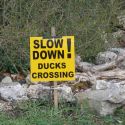Pillars - reconstructed
Local bus to Knossos, the enormous (6 acre) Bronze Age archaeological site sometimes considered to be Europe's oldest city. There were neolithic settlements here about 8000 years ago and a Minoan kingdom (approximately 3650 to 1400 BC), followed by a Mycenaean city, established by settlers (invaders?) from the Peloponnese. There is some dispute about what ended the Minoan, the oldest European civilisation, but a widely held theory is that it fell victim to the tsunami that followed a major volcanic eruption on Santorini. Certainly ash and sea deposits have been found this far inland.
Multi-storey section
A wealthy British amateur archaeologist undertook excavation and some level of restoration beginning about 1900, and what is now visible includes excavated foundations as well as reconstructions that don't pretend to be part of the original but are based on assumptions, educated guesses, and projections from what has been found. The method is somewhat controversial but definitely impressive.
Reconstructed room with lustral basin, original design/colouring
The site includes various stages and periods, and it is possible to look down shafts into the underground storeys of what was once a multi-storey complex of some 1400 rooms, including shafts for lighting and ventilation and a complex water and drainage system. Even flush toilets. At its most populous there were probably 100,000 people or more and a city area of 200 acres. It was also richly decorated.
Bull rider - copy in situ
Most of the art and artefacts discovered are now in the Archaeological Museum in Heraklion, but some copies have been created to put in situ. When we arrive about ten in the morning we are almost the only people there - we and a Saskatchewan couple we met on the nearly empty city bus coming out. Lovely breeze and surrounding fields, treed hills and mountains. We're free to wander (having passed on the €60 asked by the guide -"but you'll get lost").
Bull - right side of face reconstructed
Luckily for me, J has been here before, although he says there has been considerable development since his last visit twenty-eight years ago. But he's a good source, pointing out the motif of bull horns repeated throughout and reminding me of the myth of the minotaur, associated with the hundreds of tiny rooms that may be the originals in the story of Theseus slaying the half bull half man and finding his way out of the labyrinth.
Greek wit circa 1500 BC
In the afternoon we take the bus back in to Heraklion and visit the museum, an amazing trove of ancient pieces of art, many of them from Knossos. We're very lucky that our visit is on a Sunday, as both Knossos and Heraklion museums are free on winter Sundays.
Leda and the Swan







